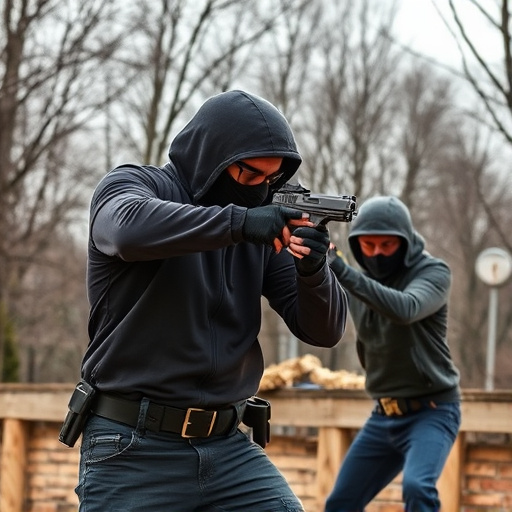Tactical pepper spray is a potent self-defense tool that temporarily incapacitates attackers by disrupting vision and breathing through capsaicin, an ingredient found in chili peppers. When used responsibly, it can provide crucial time to escape or seek help. Key features of effective tactical pepper spray include durability, reliable operation, and precise distribution. Understanding and practicing specific application techniques, focusing on targeting facial areas rich in nerve endings, is essential for maximizing its neutralizing effect.
“Uncover the power of tactical grade pepper spray, a versatile self-defense tool designed for maximum impact. In this comprehensive guide, we explore the science behind its effectiveness and the key features that make it a game-changer. From understanding how pepper spray neutralizes threats on the face to mastering application techniques, this article equips you with vital knowledge. Discover the essential design elements of tactical dispensers, ensuring you’re prepared for any situation. Get ready to learn how to deploy this powerful resource strategically.”
- Understanding Tactical Pepper Spray: Its Power and Purpose
- How Does Pepper Spray Work on the Face?
- Designing for Effectiveness: Key Features of a Tactical Grade Dispenser
- Application Techniques: Maximizing Neutralization with Pepper Spray
Understanding Tactical Pepper Spray: Its Power and Purpose
Tactical pepper spray is a powerful tool designed for self-defense and law enforcement applications, offering a quick and effective means to neutralise an attacker. Unlike traditional pepper spray, tactical grade varieties are formulated with enhanced strength and durability in mind, making them capable of penetrating eyes and airways. This ensures individuals can gain time to escape or call for help when facing dangerous situations.
When used appropriately, pepper spray can disrupt an assailant’s vision and breathing, temporarily incapacitating them. The primary purpose is not to cause permanent harm but to create a window of opportunity for the user to retreat or summon aid. Understanding its potency and responsible usage are crucial, especially as it can be a game-changer in high-risk environments where every second counts.
How Does Pepper Spray Work on the Face?
Pepper spray is a powerful tool designed to disrupt and neutralize an attacker, providing users with valuable time to escape dangerous situations. When deployed, pepper spray creates a cloud of capsaicin, the active ingredient commonly found in chili peppers. This irritant directly affects the eyes, nose, and respiratory system, leading to temporary blindness, difficulty breathing, and intense pain. The impact on the face is swift and powerful; the capsaicin binds to receptors in the eyes and nasal passages, triggering a response that includes excessive tearing, sniffing, and a burning sensation.
The ‘neutralize pepper spray on face’ process involves blocking these receptors from receiving further signals, thereby reducing the intensity of symptoms. While it’s not a permanent solution, it buys time for individuals to move away from the threat, seek safety, and potentially call for help. This rapid response makes pepper spray an effective self-defense mechanism, especially in close-quarters combat where traditional weapons may not be readily available or practical.
Designing for Effectiveness: Key Features of a Tactical Grade Dispenser
When designing a tactical grade pepper spray dispenser, the primary focus is to ensure its effectiveness in neutralizing pepper spray on face and other high-risk areas. Key features include a durable build that can withstand harsh conditions, such as impact resistance and water-proofing. The mechanism should be reliable and easy to operate, even under stress, allowing users to deploy the spray quickly and accurately. A tactical dispenser often incorporates advanced nozzles for better distribution, reaching targets at various distances and angles.
Additionally, safety features like a quick-release trigger and a built-in safety lock are crucial. These prevent accidental discharge and ensure the device remains secure during transport. The size and weight of the dispenser should be optimized for ease of carrying without compromising functionality. Incorporating stun capabilities or additional tools can enhance its tactical value, making it a versatile tool for law enforcement and personal defense.
Application Techniques: Maximizing Neutralization with Pepper Spray
When it comes to tactical grade pepper spray, understanding application techniques is key to maximizing its neutralizing effect, especially when targeting the face. The face is a sensitive area, and aiming for specific points can enhance the spray’s impact while minimizing collateral damage. One effective method is to target the eyes, nose, and mouth—areas with numerous nerve endings that are responsible for sight, smell, and taste. A direct hit here can cause temporary blindness, irritation, and difficulty breathing, effectively neutralizing an aggressor.
To ensure optimal results when applying pepper spray on the face, users should practice different techniques in controlled settings. This includes learning to control the spray’s range, ensuring a close proximity for maximum effectiveness. Additionally, understanding wind patterns and the direction of the spray can improve accuracy. With proper training, individuals can master these application techniques, enhancing their self-defense capabilities and ensuring they have a strategic advantage when facing potential threats.
In conclusion, tactical grade pepper spray dispensers are powerful tools for self-defense, designed to quickly neutralize threats by overwhelming sensory systems. Understanding how it works and mastering application techniques can ensure its effectiveness in real-world scenarios. By choosing a well-designed dispenser with key features and employing proper usage methods, individuals can gain valuable peace of mind and enhanced personal safety.
